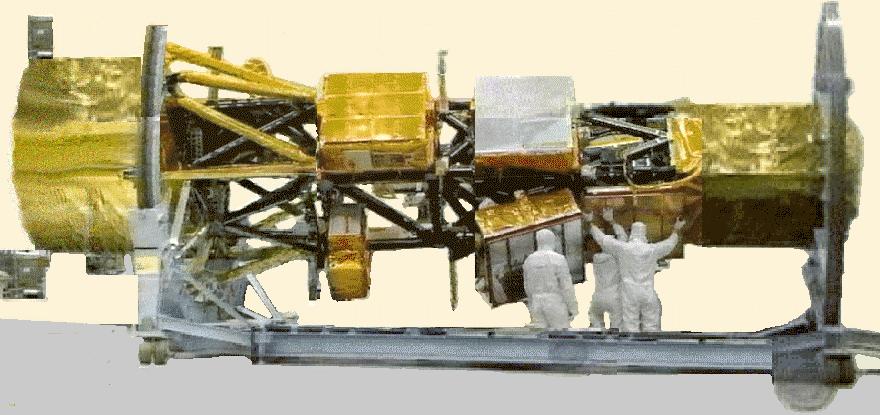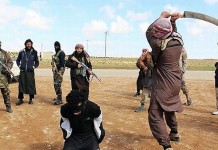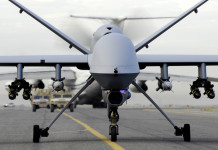The Krasukha-4 is a broad-band multi-functional jamming system designed to neutralize Low-Earth Orbit (LEO) spy satellites such as the US Lacrosse/Onyx series, airborne surveillance radars and radar-guided ordinance at ranges between 150km to 300km. The system is reported to have the ability to cause damage to the enemy’s EW systems and communications. The Krasukha-4 system works by creating highly effective jamming at the fundamental radar frequencies and different radio-emitting sources.
In recent weeks, Russia has also deployed the IL-20 surveillance plane, better recognized by its NATO title “Coot” and roughly equal to the U.S. Navy’s P-3 Orion, a mainstay of the Pentagon’s spy tools. The Russian aircraft is bristling with high-tech equipment like surveillance radar, electronic eavesdropping gear, and optical and infrared sensors. One of the Kremlin’s premier spy planes, it offers Russian forces with a powerful tool for finding rebel units and assigning targets to its fighter planes. In late September, Syrian rebels posted a video purporting to show the aircraft flying over a battlefield.
https://www.youtube.com/watch?v=9qwNY9GFXp8
The deployment of the IL-20, or Coot, is probably the clearest indication that Russian President Vladimir Putin wants to ensure his troops in Syria aren’t reliant on Assad’s forces for targeting info — and that they could be getting ready for a ground combat position. On Monday, Moscow said “volunteer” troops could be heading to Syria to join the battle there, a barely disguised sign that Russian forces might soon be directly battling U.S.-backed and trained rebels inside Syria.

Russia’s transfer of advanced electronic warfare tools to Syria is the latest instance of Moscow’s so-called “hybrid warfare” tactics, which use deception and covert operations to achieve strategic objectives with a minimal use of military force. The Krasukha-4 was also noticed in Ukraine and played a key part in Russia’s campaign of electric warfare there, which Kiev claimed resulted in a disruption of cell service at times. The deployment of the Krasukha, which can be utilized to disable aircraft avionics, came at around the same time that Western policymakers publicly entertained the idea of creating a no-fly zone over eastern Ukraine. The positioning of the Krasukha, along with other air defenses, prevented the enforcement of such a no-fly zone and kept Kremlin in charge of the skies, according to Igor Sutyagin, a senior research fellow at the Royal United Services Institute, a London based think tank.
Now, too, the Krasukha has been put in place as several countries are calling for the establishment of a no-fly zone in northern Syria. Sutyagin described the deployment of the Krasukha as an effective “no-fly zone for those who wish to create a no-fly zone.” For now, there isn’t any proof that the electronic warfare system has been used against American and other coalition planes flying in the skies over Syria, however its presence has surely been noted by the Americans.
The usage of cutting-edge signals intelligence and electronic warfare tools is indicative of Russian intentions in Syria. Jeffrey White, a fellow at the Washington Institute for Near East Policy and a 34-year veteran of the U.S. Defense Intelligence Agency, described the rebels as not “that hard a SIGINT target,” utilizing a shorthand term for signals intelligence, or transmissions plucked off the airwaves. “Do [the Russians] want their best and most sophisticated collection techniques and methods?”
Russia’s use of the new tools — particularly the equipment designed to provide more precise targeting data — comes amid a fierce debate between Russian and the American administration over Russia’s true targets in its Syria air war. Russian leaders insist they’re only hitting targets tied to the Islamic State, however rebel groups in the country — backed by senior U.S. officers like Defense Secretary Ash Carter — say Moscow is actually dropping virtually all of its ordnance in areas held by groups combating Assad.
Russia and Syria have a long history of intelligence cooperation in the fight against the country’s rebels, and Russia has previously provided alerts intelligence expertise to the Syrian authorities. In October 2014, rebels overran a Syrian military base close to the Golan Heights, discovered a joint Russian-Syrian listening post, and posted a video tour of the secretive facility.
Asked in regards to the intensified Russian intelligence buildup in Syria, one U.S. senior defense official remained closed-lipped about Moscow’s capabilities there apart from acknowledging the sophisticated instruments at Russian troops’ disposal and that “their operational patterns remain the same” as in Ukraine. Speaking on condition of anonymity to discuss classified details, the official stated that Russia has concealed communications and movements as it did in Ukraine, including by hiding Russian fighter jets within the signature of larger cargo jets.

Other assets deployed to Syria include the R-166-0.5 signals vehicle, which provides command and control functions for a battalion of Russian ground troops. Its presence in Syria is intriguing, Sutyagin stated, because it implies the presence of a battalion-strength detachment of ground troops. On Monday, Interfax reported that the Vasily Tatishchev, an advanced naval surveillance ship, has sailed for the eastern Mediterranean.

Earlier this summer, military blogs reported that the Syrian military had obtained from Russia a brand new batch of R-330P communication jammers. The simple radio communications tools utilized by anti-Assad rebels are simple fodder for such a system and could be used to undermine coordination by insurgent forces in mounting operations and offensives.
Between the Krasukha, the IL-20, and the Vasily Tatishchev — along with the reported presence of surveillance drones — Russia has poured its best assets into Syria against targets that really shouldn’t be particularly hard for the country’s air force to hit. However that deployment is still quite small, and its concentrated use has allowed Putin to achieve his objectives with a minimal amount of effort.
Since the starting of the Arab Spring, NATO countries led by the US and directly supported by the UK have been actively gathering intelligence from countries using EW assets together with low-orbit surveillance satellites (Lacrosse/Onyx series), reconnaissance planes (NATO E3 Sentry (AWACS), USAF RC135-Rivet Joint, RAF’s Sentinel R1 and Reaper drones), and sharing intelligence data with the side being supported in the battle.

Since the land grab by the self-proclaimed Islamic State (IS) in both Iraq and Syria, NATO’s EW assets have been targeting IS insurgents fighting units, gathering intelligence to offer tactical target info and to actively engage IS by denying rebel units radio communication and surveillance information – thus electronically blinding them. Sanitized intelligence information is shared with friendly forces including the rebel forces fighting against Syrian president Bashar al-Assad.
Until September 2015, Russia has been supporting Assad by supplying arms and training to Syrian forces. Bolstered by what it sees as Western indecisiveness on a Syria solution and by the West’s inaction on Russia’s military intervention in the Ukraine, Russia has decided to provide direct military air support to Syria. Nonetheless, Assad’s enemies comprise all rebel groups opposing his rule – not just IS.
So how can the Krasukha-4 be used to cloak Russia’s operations in Syria? In words – partially effectively. Its surveillance techniques won’t only be able to monitor NATO airplanes movement over Syria but also the types, and from its intelligence it’ll know the frequencies used and signal characteristics present – Lacrosse satellites and AWACS operate in S-band, Sentinel (and similar) in X-band, and drones in J-band. Lacrosse/Onyx satellite positions are regularly tracked by Russia. With this intelligence detail the Krasukha-4 could be programmed to engage so as to deny or disrupt NATO intelligence gathering.

However it isn’t all one way – US and NATO intelligence gatherers will have “electronic counter counter measures” (ECCM) to fight Russian EW interference – and so the cat and mouse game of the Cold War is repeated. Intelligence gathering and radar-guided munitions will suffer some disruption and errors may be made however operations will continue.
ECCM might include being frequency agile and dodging the jamming signal or pointing the receiving antenna away slightly from the jamming source. There are additionally many methods that may be played with signal processing that can mitigate the effects of jamming. After all, it might even be possible for NATO to jam the Russian surveillance radar, denying them of identification and positioning of NATO planes – but this may really ramp up the confrontation with Vladimir Putin.
Russia will now be able to test its new EW techniques in live combat but avoiding direct conflict with NATO – it’ll improve overseas sales prospects of the Krasukha-4 system. NATO shall be in a position to test its ECCM against another EW system, presumably with similar ends in mind.
Tags: turkish log jammer, russian military, future power weapons











[…] Source: Spy Planes, Signal Jammers, and the High-Tech War in Syria […]
[…] Source: Spy Planes, Signal Jammers, and the High-Tech War in Syria […]
[…] Source: Spy Planes, Signal Jammers, and the High-Tech War in Syria […]